Sunrises on Kri Island are unique. There is an original combination of blues, yellows and pinks rising from behind the small Koh island, just in front of the RARCC, fighting for attention against a translucent moon insisting on staying in this perfect scenario.
Every morning a bird chorus makes the sweetest alarm ever. When we are lucky, also the sound of soft waves is interrupted by a baby blacktip reef shark that jumps outside the water practicing its twirl.
Even though Raja Ampat is well-known for its extraordinary underwater world, many guests and researchers come to Raja Ampat only to testify its beauty in the land.
In fact, with 90% forest cover, West Papua holds one of the world’s most important intact rainforests. Visitors can find here the largest mangrove forest on Earth.
Birdwatching is considered an exciting activity to do in Raja Ampat. According to the Avibase – Bird Checklists of the World, Raja Ampat has 362 species of birds. Wilson’s and Red Birds of Paradise, which are among the most beautiful birds on Earth, can be found in this area, and Papua Diving and Kayak4Conservation guests are invited to join trips to other islands to see these birds.
Even though we can’t find these two species here, Kri Island has forests rich in bird life. There are several species, including parrots, lorikeets, cockatoos, kingfishers, kookaburras, hornbills, butcherbirds, pigeons, sunbirds, honeyeaters, swallows, and wagtails, scrubfowls, egrets, white-headed shelducks, frigatebirds and fish eagles.
Below please find more information about the ones that make our ears rejoice.
Guests can find on this tropical island the Rufous-bellied Kookaburra, which only lives in dense rainforests, isolated or in pairs. Despite their direct flights, sometimes to get large insects from trees, they can do very sharp twists. These birds hunt small vertebrates as well. Males are very defensive of their territory, which can reach 2.5 hectares, and sometimes they even attack outsiders violently.
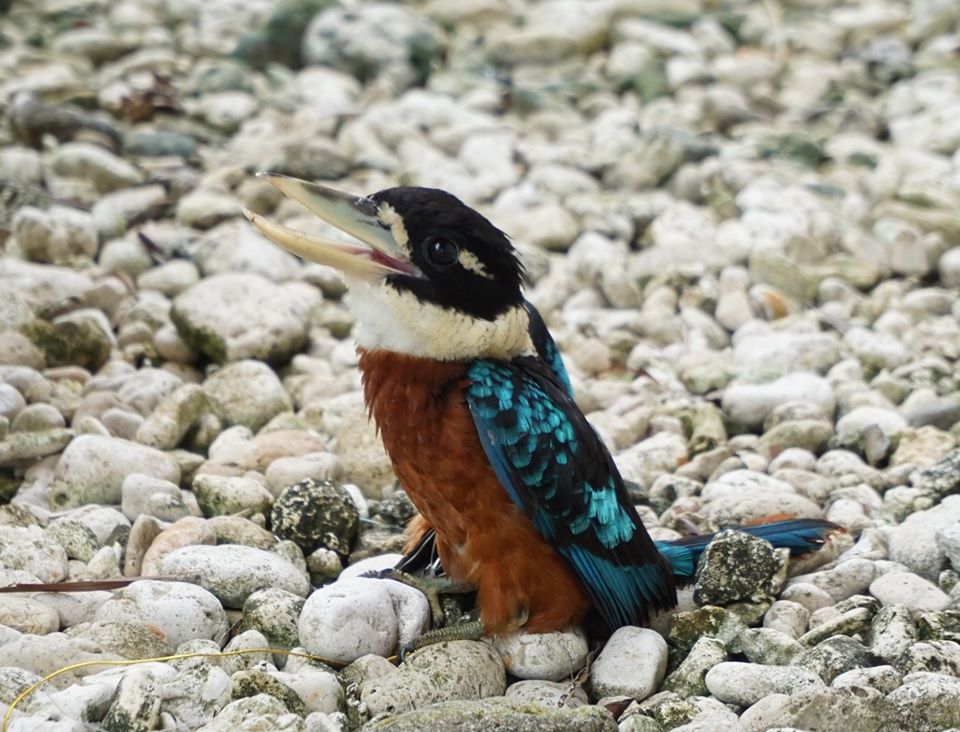
Glossy-mantled Manucode is a species of Bird-of-Paradise with around 42 cm long. It is green, blue and purple black, and has a black bill and a long tail. They eat fruits, possibly flowers, insects and worms, and they use to move alone or in pairs, but not often in groups. It is easier to hear their high pitched sounds than to observe them directly.
All Paradise Kingfishers have colourful plumage and red bills and usually they stay still for long periods. The Common Paradise Kingfisher is non-migratory, even though some birds leave the monsoon rainforest in the dry season. Their nest is in an active termite nest in a tree, and they can make holes as long as 13 cm. A pair defends a territory of up to 0.5 hectares and both parents take care of their chick. Earthworms, grasshoppers, beetles, caterpillars, centipedes and snails, and sometimes lizards are part of their diet. Their victims are usually dismembered or subdued by bashing them against the branches.
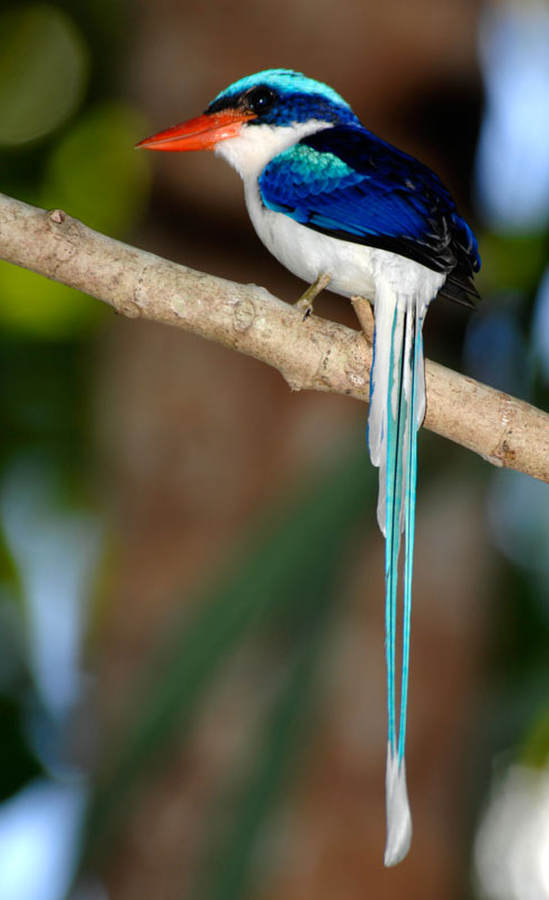
The Willie Wagtail is not a common black and white bird, since it has white eyebrows and whisker marks. Measuring 19–21.5 cm, this bird has a tail of 10-11 cm long and a short bill. Although it is active in defending its territory, we can find the Willie Wagtail in open habitats and even around houses. Usually they travel by themselves or in pairs, and they hunt insects in active chases in the air or even on the ground, wagging their tails from side to side. It has many distinct and melodious sounds, but the most-recognised one seems an alarm call, which it does to warn off potential rivals and threats.
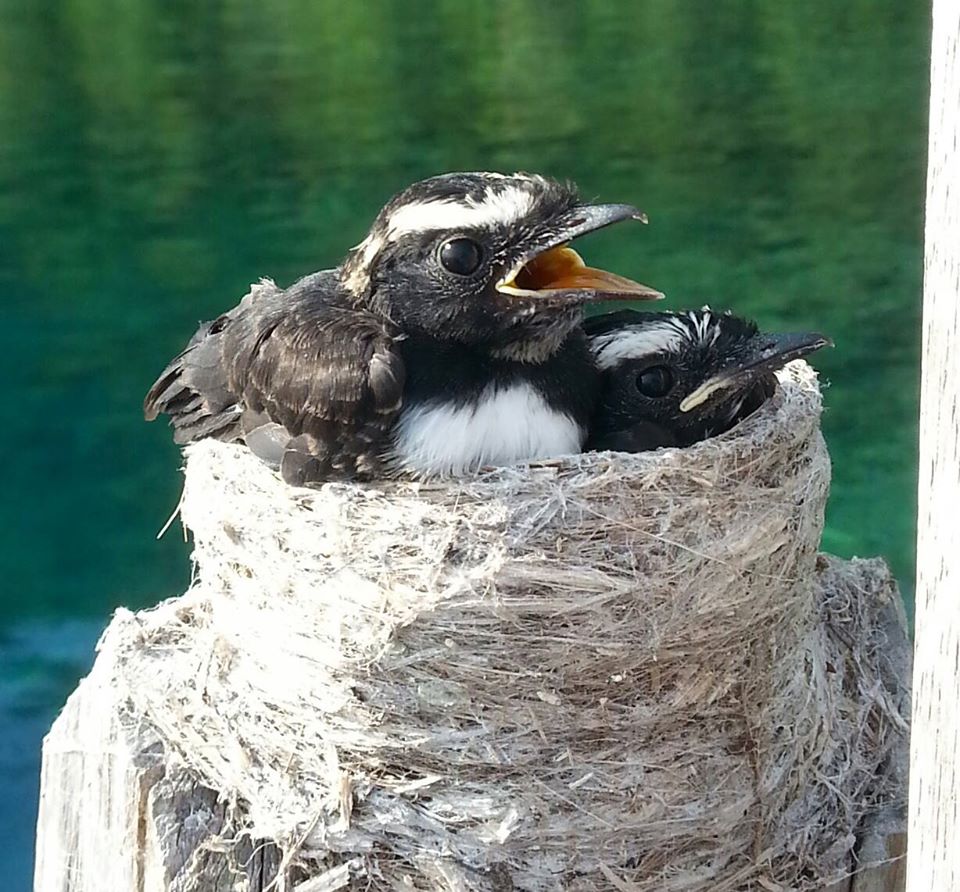
The sedentary but noisy Hooded Butcherbird measures up to 35 cm and has a black head and throat and strong bill slightly hooked. It likes to stay in subtropical or tropical moist lowland forests, and can be found close to houses in coconut groves. They are usually found in pairs or small family groups, and they eat large insects, larvae, spiders, fruits and small vertebrates, including birds.
The Scrubfowl are stocky chicken like birds with small heads, long pointed crest and large feet. This very vocal chicken measures around 30-47 cm and it has the particularity of not incubate its eggs as most of the chicken. It actually buries its eggs and builds a massive mound of vegetation, adding or taking litter to regulate the internal heat. It can be found in rainforests and other wooded areas, including swamp-forest. Their meals consist of seeds, berries, roots, fruits, shoots and flowers, and sometimes, they also eat young snakes, snails, worms and scorpions.
The Eclectus Parrot is one of the larger parrot species and has the particularity of a strong sexual dimorphism: the males have a green plumage and females a light red or purple one. In fact, their beautiful feathers are used by tribes in Papua as decorations. They live in tropical rainforests and eat mainly fruits, nuts, flowers and leaf buds and seeds. Their nests are made high up in the trees and they fight for their nest against other females and stay there for up to eleven months. Females with bad nest hollows often commit infanticide on the male, if they have a male and a female. They rely on males to bring them food and each female can be feed by up to five males. In fact, unlike other parrot species, the Eclectus Parrot is polygamous. This bird makes amusing and loud sounds.
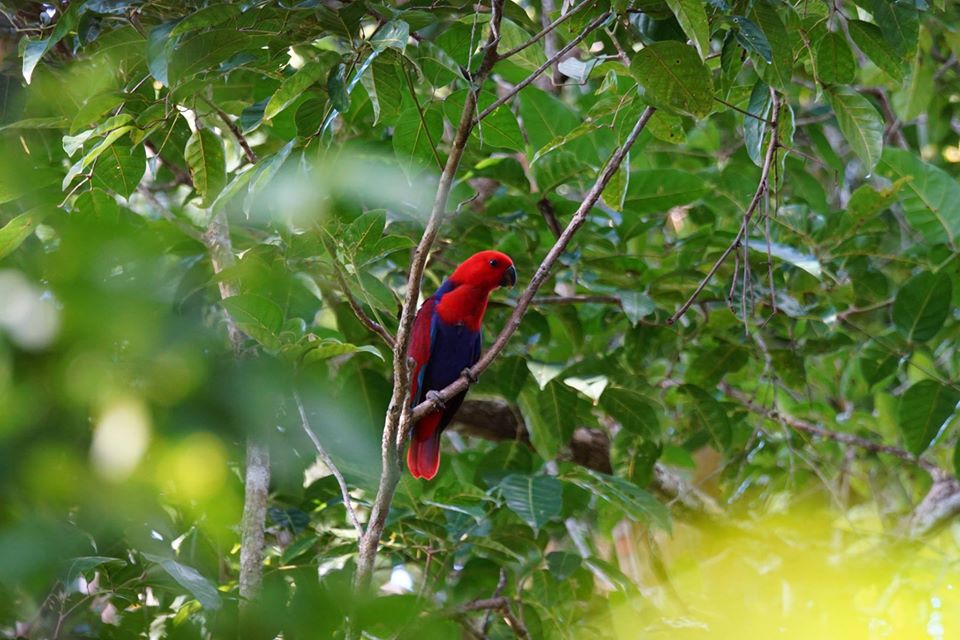
The Sulphur-crested Cockatoo is one of the largest white cockatoos with up to 55 cm, and with an ostentatious yellow crest. It is considered a curious and highly intelligent bird and it can live 70 years in captivity and about 20-40 years in the wild. In fact, they eat clay to detoxify their meals. Their nest is made of wood chips in a hollow in a tree, and both parents incubate the eggs and even compete with others for nesting sites. To protect themselves from predators while eating on the ground, one of them stays in a tree. The Sulphur-crested Cockatoo makes very loud sounds and it can synchronise movements to a musical beat.
The following birds have also been observed on Kri island from 28th September until 26th October 2014, by David Bishop and Jared Diamond.
- Lesser Frigatebird
- Eastern Reef Egret
- Great- billed Heron
- Osprey
- Brahminy Kite
- White-beaded Shelduck
- Whimbrel
- Common Sandpiper
- Crested Tern
- Red –necked Phalarope
- Stephan’s Ground Dove
- White –breasted Fruit Dove
- Claret breasted Fruit Dove
- (Spice) Imperial Pigeon
- Violet-necked Lory
- Red-Cheeked Parrot
- Great-billed Parrot
- Channel –billed Cuckoo
- Large-tailed Nightjar
- Fork –tailed Swift
- Uniform Swiftlet
- Sacred Kingfisher
- Beach Kingfisher
- Blyth’s Hornbill
- Pacific Swallow
- Gray’s Grasshopper – Warbler
- Yellow-bellied Gerygone
- Northern Fantail
- Island Monarch
- Spot – winged Monarch
- Shinning Flycatcher
- Island Whistler
- Yellow -bellied sunbird
- Varied Honeyeater
- Mimic Meliphaga
- Singing Starling
- Moluccan Starling
- Metallic Starling
- White –breasted Wood-Swallow
- Torresian Crow
Besides these birds, guests can also find other animals, such as:
The cutest inhabitants of the island are probably the Cuscuses. These furry marsupials are nocturnal and can often be found around the dinner tables hoping to find bananas. It is a little bit odd when they stare at something with their large cat-like eyes. This also cat-sized animal seems to wear a beautiful coat: females are creamy with a ginger face, while the males are ginger with white splotches. They have very small ears, long tail and claws, which helps them to stay in the trees. The Cuscuses sleep in trees with their head between their legs, wrapped in leaves.
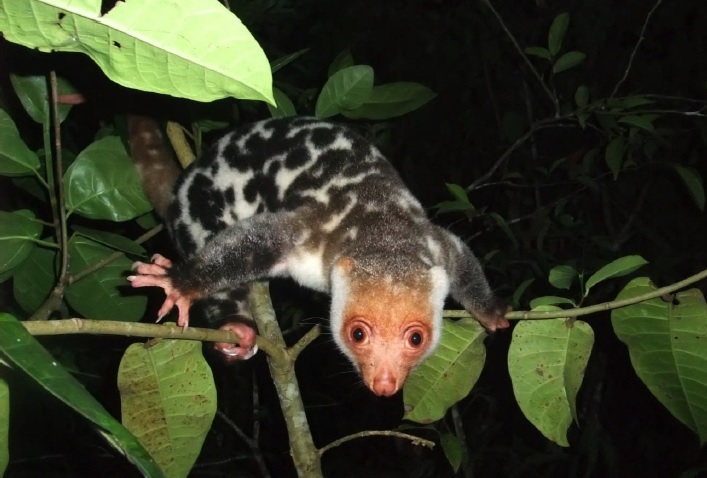
Flying foxes, also known as fruit bats or Pteropus, are one of the largest bats, with a wingspan up to 1.5 meters and a body of about 40 cm. In some areas of Raja Ampat, there are in a big number. Many bats, like dolphins, use echolocation (find the location of something by measuring the time it takes for an echo to return from it), but not this one. Instead, they use sight and not all are nocturnal, even though most are. Fruits and other plants and insects are part of the diet of flying foxes, which find resources by just smelling them. Even though in many places they are vulnerable to hunting, they assist to regenerate forests via seed dispersal and help the ecosystems by pollinating plants, which affects positively humans as well.
Hermit crab species range in size and shape, with some of them measuring only a few millimetres long. Some also live only for a few months and others can reach 32 years. Most of the approximately 1,110 species have long, spirally curved abdomens inside a shell, where they can protect themselves from predators. As they grow, they need larger shells, which may lead to a competition if there are not many gastropods around. Some are marine hermit crabs and spend most of their life underwater. Others are land hermit crabs that live on the land in tropical areas, even though they need to look for freshwater and saltwater to keep their gills damp to survive and to reproduce. Most of them are nocturnal, and we need to be careful when we walk because sometimes it is hard to differentiate them from rocks.
The coconut crab is a species of terrestrial hermit crab, and it can grow to up to 1 m in length from leg to leg and live for 60 years. Like other hermit crabs, juvenile coconut crabs use empty gastropod shells for protection, but they get rid of them when they become adults because they develop a tough exoskeleton on the abdomen. This animal has branchiostegal lungs instead of vestigial gills, which means after the juvenile stage, it will drown if immersed in the water for too long. Coconut crabs look for food with a good sense of smell, and they eat especially fruits, nuts, seeds, and the pith of fallen trees. However, if they find something on the ground, they will carry it away to check if it is eatable, that is why this species is also known as “robber crab”. These nocturnal animals can climb trees as a way of escaping from predators, but they live in burrows.
Monitor lizards are large lizards with long necks and strong tails. They might seem unfriendly at first, but they are shy. It is funny how they would do everything to run away from humans. We can find monitor lizards often in the trees, in the walkways, sometimes even two fighting each other, or just sunbathing on the beach. They can eat fish, reptiles, birds or mammals. We can find them in groups, but most of the time they are solitary.
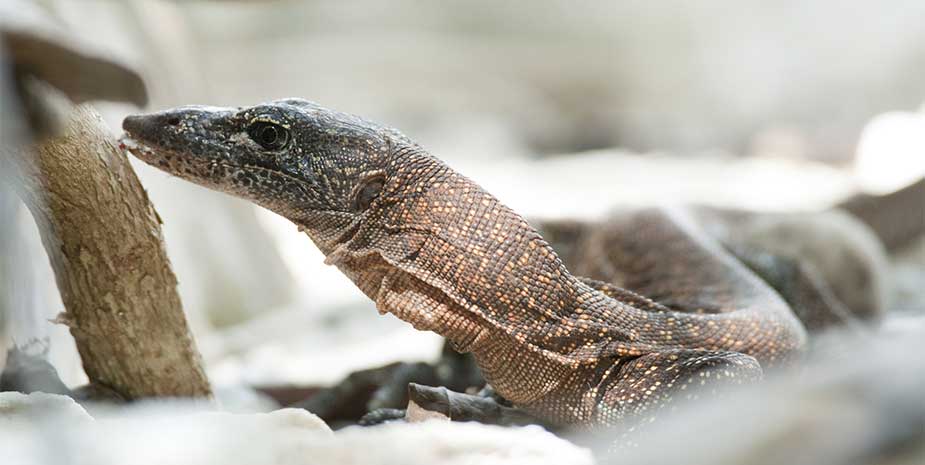
From the same family, but with a dimension much smaller, we have geckos. Their clicks and the sound they make when they drop on the floor is the best way to know they are around. Most geckos cannot blink, but they lick their eyes to keep them moist. These animals have a fixed lens in their iris that enlarges in darkness to let in more light. Like most lizards, geckos may lose their tails in defense. They have toe pads that enable them to climb smooth vertical surfaces. In fact, they are often inside buildings, which helps humans in warm regions because they eat insects.
On Kri island, there is also a large variety of insects, including butterflies, grasshoppers and fireflies, and spiders.
Last but not least, Kri grounds are covered with several species of wild orchids.
Biography:
Brittanica, Wikipedia, Handbook of the Birds of the World, The Spruce Pets, Birds in Back Yards, Experience the Wild, Lafeber, WCS Papua New Guinea, Australian Geographic.











